WHY WE TRADE
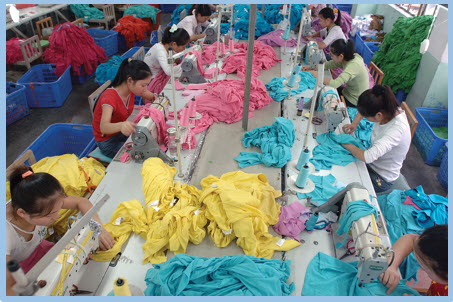
Chinese Factory Workers Preparing Goods for Export
Unit
Overview
Very
few days pass in the United States without media headlines concerning
international trade. Should the United
States impose sanctions that limit trade with certain countries? Do the trade policies of other nations give
them an unfair advantage? How should
Americans respond to concerns about the trade deficit? All of these issues sometimes make people
wonder if trade is really worth the hassle.
Economists, however, maintain that international trade improves the
global standard of living and encourages healthy economic competition. They use the basic principles of economics to
explain why this is true. Let's see how
it all works.
Why Do
We Trade?
Why
do we trade? For the most part, nations
trade for the same reasons people do.
They believe that the goods and services received are more valuable than
those which they are giving up. If you
ask an economist this question, he or she would likely answer that trade
happens because resources are scarce and unequally distributed around the
globe. Within their borders, countries vary
dramatically in the amount of land available for farming, mineral deposits, oil
reserves, timber and other things too numerous to list. Climate and geographic features, such as
mountains, waterways and desserts, also limit a nation's ability to produce all
the goods and services that citizens want and need. The table below compares four countries in
eight categories. Each nation possesses
different natural, human and physical resources. Trade is one way for a nation
to make up for what it lacks.
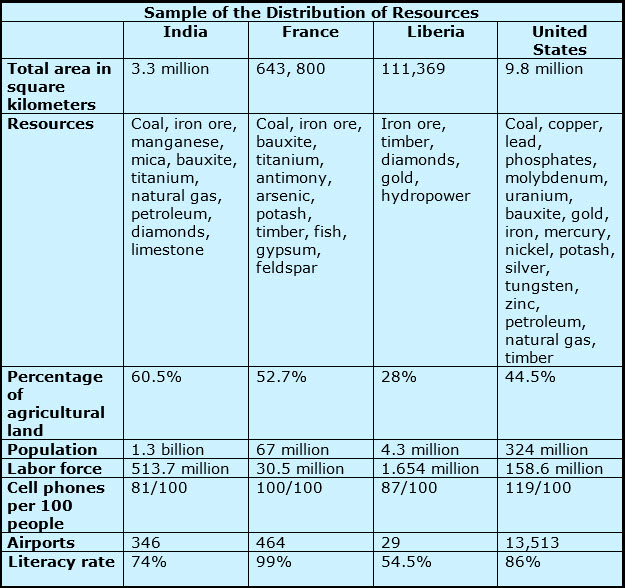
At
the same time, there are major differences in the available physical capital, or human-made
materials, needed to create certain goods.
Infrastructure, including roads and bridges, airports, factories, power
plants, tools and machinery, fall into this category and are not readily
accessible in some regions of the world.
Industry also requires human capital, or skilled workers. To measure a country's human capital,
economists often refer to the literacy
rate. This is the percentage of
people over the age of fifteen who can read and write. A high literacy rate likely represents an
educated and capable work force. History
and culture, too, play a role in a country's allocation of resources. For example, long periods of civil warfare or
frequent invasions tend to reduce a nation's capacity to produce goods and
services.
We
also trade simply because it gives us more of what we want. When
today's shopper visits a mall, he or she is likely to come home with clothes
from China, shoes from Indonesia and a bicycle helmet made in France. This extensive variety of products is the
result of international trade. It gives
consumers more choices, lowers costs and improves quality by encouraging competition. At the same time, statistics seem to indicate
that countries engaged in international trade develop a higher standard of
living. Trade also creates a global economic interdependence that builds
relationships and promotes peace.
However, like all decisions, the choices surrounding international trade
come with opportunity costs.
![]() Go to Questions 1 through 6.
Go to Questions 1 through 6.
Absolute
and Comparative Advantage
How
do nations decide what to produce, how to produce and for whom to produce goods
and services when it comes to trade? Because
countries differ in resources, capital, climate and geography, they sometimes
concentrate on certain items rather than producing everything themselves. This is referred to as specialization. For example, Guatemala has very limited mineral
resources, but it does have the right soil and climate to produce large
quantities of bananas. By exporting
bananas, it earns the money to purchase products that it cannot manufacture
efficiently. Does this example mean that
a country with ample resources has no reason to trade? If a nation has access to the latest
technology and has educated a well-trained workforce, can it ignore global
trade and become self-sufficient? In
reality, countries with more-than-adequate resources as well as limited ones
can benefit from trade. Two economic
concepts, absolute advantage and comparative advantage, explain why this is
possible.
When
one country produces more of a particular product than other nations who
manufacture less with the same amount of resources, it is said to have an absolute advantage over its competitors.
Let's see how it works with the imaginary countries of Mocha and Macadamia. Both countries are almost equal in size,
population and available capital. Each
one only grows two crops—coffee beans and macadamia nuts. If both countries dedicate all their
resources to growing coffee beans, Mocha can produce 40,000,000 pounds of coffee
annually, while Macadamia can only produce 6,000,000 pounds of the same good in
the same time period. Clearly, Mocha has
the absolute advantage. What happens if
both countries shift to growing only macadamia nuts? Mocha produces 8,000,000 pounds of nuts, but
Macadamia produces 6,000,000 pounds.
Once again, Mocha has the absolute advantage.

At first,
economists believed that absolute advantage was the basis for trade because it
permitted a country to manufacture enough of a particular good to satisfy its
population and to sell the remainder in the world market. However, it soon became obvious that trade
benefitted countries with abundant resources as well as those with few
resources. In the early nineteenth
century, David Ricardo, a British
economist, argued that the key to trade is not which country produces the most
of one product with the fewest resources but the country that produces the most
at the lowest opportunity cost. This concept is referred to as comparative advantage. Remember—opportunity cost is what you give up
when you choose to do one thing rather than another.
Let's
take a second look at Mocha and Macadamia using comparative advantage. If Mocha shifts its production to macadamia
nuts only, it gives up 40,000,000 pounds of coffee. This is an opportunity cost of five pounds of
coffee for every one pound of macadamia nuts produced. For Macadamia, the opportunity cost that
results from growing just macadamia nuts is much lower. Because it is giving up 6,000,000 pounds of
coffee beans to produce 6,000,000 pounds of macadamia nuts, the opportunity
cost for 1 pound of nuts is 1 pound of coffee.
Since the same pound of macadamia nuts costs Mocha five pounds of
coffee, Macadamia has the comparative advantage for this product.
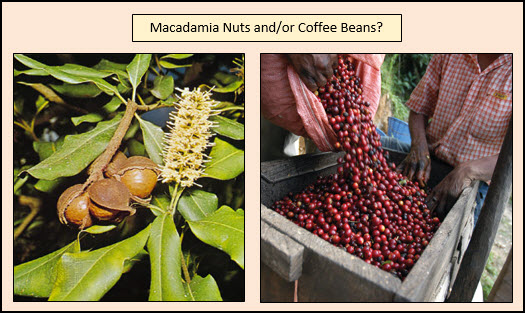
Who
has the comparative advantage when both countries shift to producing just
coffee? For every one pound of coffee
that it produces, Mocha gives up 1/5 pound of macadamia nuts. If Macadamia produces only coffee, its
opportunity cost is one pound of macadamia nuts. When it comes to coffee, Mocha has the lower
opportunity cost and, therefore, the comparative advantage. The citizens of
Mocha actually make more money by producing coffee and, in turn, by trading for
macadamia nuts. This is a good
illustration of the law of comparative advantage, which says that a nation is
better off when it produces goods and services that result in a comparative
advantage. It can then use the money to
buy other goods that it cannot produce as efficiently.

Here
is an example of how two real countries use comparative advantage so that each
one benefits. The United States has the
resources, physical capital and skilled labor force to manufacture farm
equipment at a comparative advantage.
Columbia, however, does not. It
does have the climate, capital and skilled labor required to produce coffee
beans. Because Columbia has the
comparative advantage in the production of coffee beans, it concentrates of
that particular good and exports coffee to the United States. Through this transaction, Columbia earns the
money to purchase farm equipment from the United States. The United States benefits by selling the
farm machinery and by having access to a supply of coffee. This makes the two countries trading partners. Trading partners often negotiate agreements
so that each country gets the most for its money.
![]() Go to Questions 7
through 14.
Go to Questions 7
through 14.
Trade
Surpluses and Deficits
In
terms of world trade, the United States is a major exporter and a major importer. An export
is a good that is sent to another country for sale. The United States has a wide range of
exports, including medical equipment, vehicles, agricultural products,
plastics, spacecraft and computer software.
Although goods make up most of the items sold in the global market,
services, such as educational programs, data processing, financial services and
medical care, have grown in recent decades.
Imports, on the other hand,
are goods brought in by other countries for sale. America's top imports include oil, furniture,
machinery, pharmaceuticals, vehicles and precious metals. Note that there are some things that the U.S.
imports and exports. The countries with
whom the United States exchanges the most goods and services are listed in the
charts below.

Nations
traditionally have preferred to maintain a balance of trade so that the value
of their imports roughly equals the value of their exports. This keeps their currency stable in the
international market. When a country's
exports are greater than its imports, it experiences a trade surplus. Currently,
China, Russia and Japan run large surpluses of trade. When a country imports more than it exports,
a trade deficit occurs. Spain, the United Kingdom, Australia, Mexico
and Brazil often have trade deficits, but the United States over several
decades has accumulated the world's largest trading deficit.
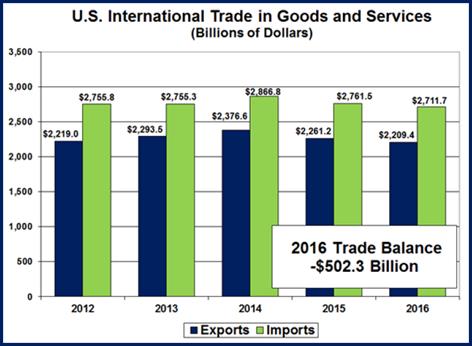
Information
Courtesy of the Bureau of Economic Analysis:
U.S. Department of Commerce
The
massive U.S. trade deficit, which climbed to over $500 billion in 2016, is a
subject of continuous debate. Some
economists predict that it will result in the decline of the gross domestic
product and in the loss of American manufacturing jobs. These same experts expect the trade deficit
to weaken the American dollar, to increase inflation and to promote the sale of
U.S. assets to foreign interests. It
also makes it easier for countries to become currency manipulators.
Through the process of selling their own currency and buying foreign
cash, such as the U.S. dollar, nations can devalue their own money and gain an
advantage in the global marketplace. The
diagram below explains how it works.

At the same time, other economists claim that
trade deficits are positive. By shifting
the production of certain goods to countries outside the United States,
American businesses use their resources more efficiently. The dollars that U.S. citizens spend on
foreign products eventually have to go somewhere. Often, this cash makes its way back to the
United States through investments in American companies. This money funds
research, new technology and upgraded equipment. Milton
Friedman is one economist who believed that Americans needed to rethink
their view of the trade deficit. Before
his death in 2006, Friedman served as economic advisor to President Ronald
Reagan and won a Nobel Prize in economic sciences. In a passage from one of his speeches quoted in
the graphic below, he suggests that perhaps we are simply looking at it
wrong. Is a deficit bad and a surplus
good? According to Friedman, it may be
just the opposite.
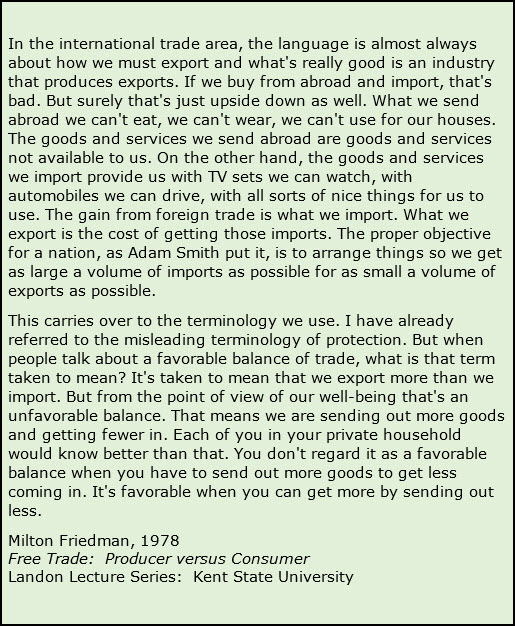
![]() Go to Questions 15
through 22.
Go to Questions 15
through 22.
What's
next?
Although
international trade has its benefits, workers and businesses sometimes experience
its painful side effects as cheaper, foreign goods enter the marketplace. This can result in lost jobs and closed
plants. In an attempt to solve these
problems, governments add regulations, or trade barriers, to limit the influx
of certain goods. Are these measures
effective? Do they create more problems
than they solve? Do they really save
jobs? Before answering these questions
in the next unit, review the names and terms found in Unit 15; then, answer
Questions 23 through 32.
![]() Go to Questions 23
through 32.
Go to Questions 23
through 32.
 |
| Unit 15 Main Points Worksheet |
| Unit 15 Calculating Comparative Advantage Worksheet |
| Unit Ah non! As croissants go global, France butter shortages bite Article and Quiz |